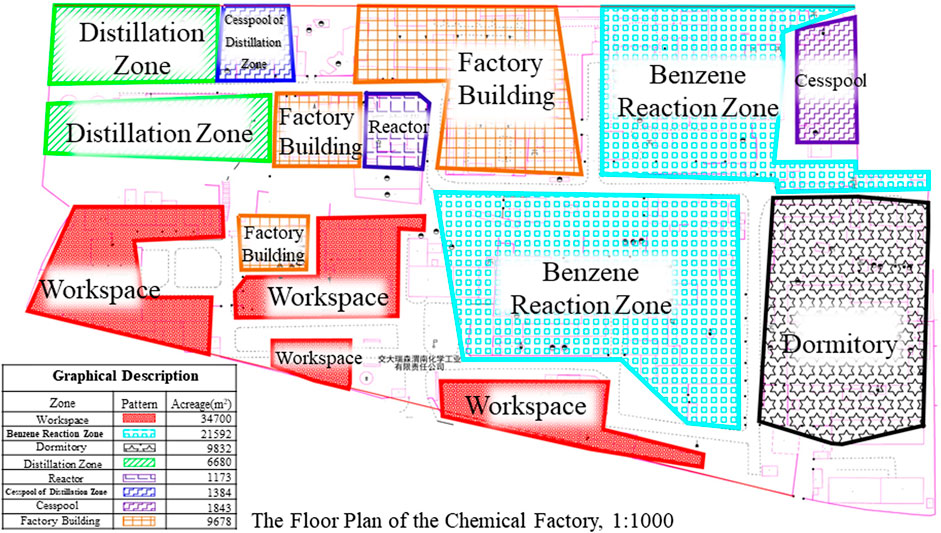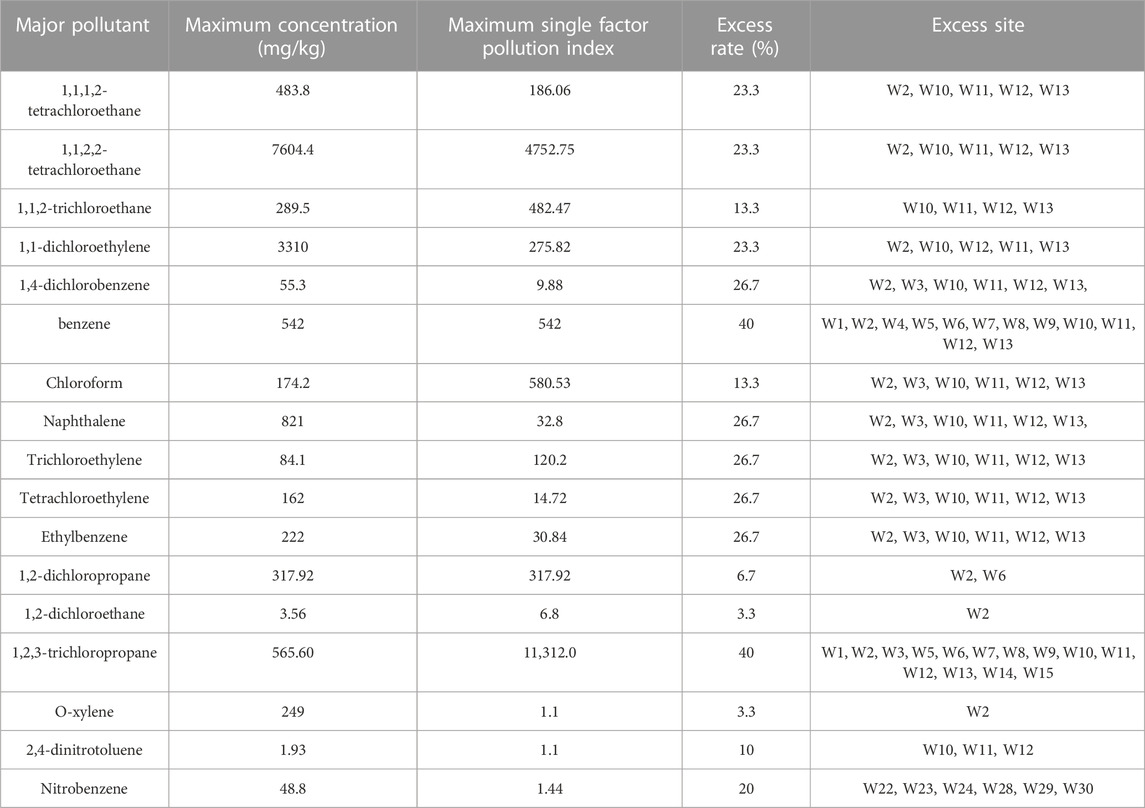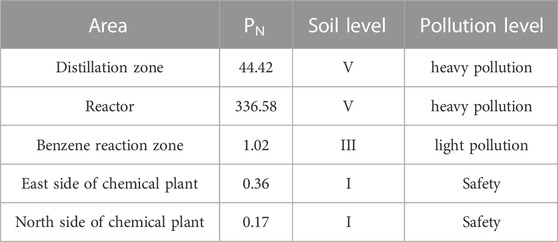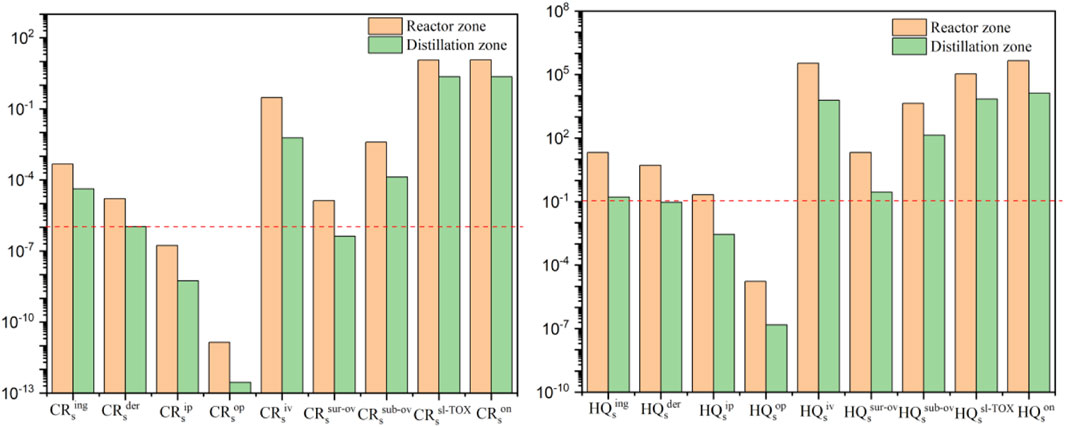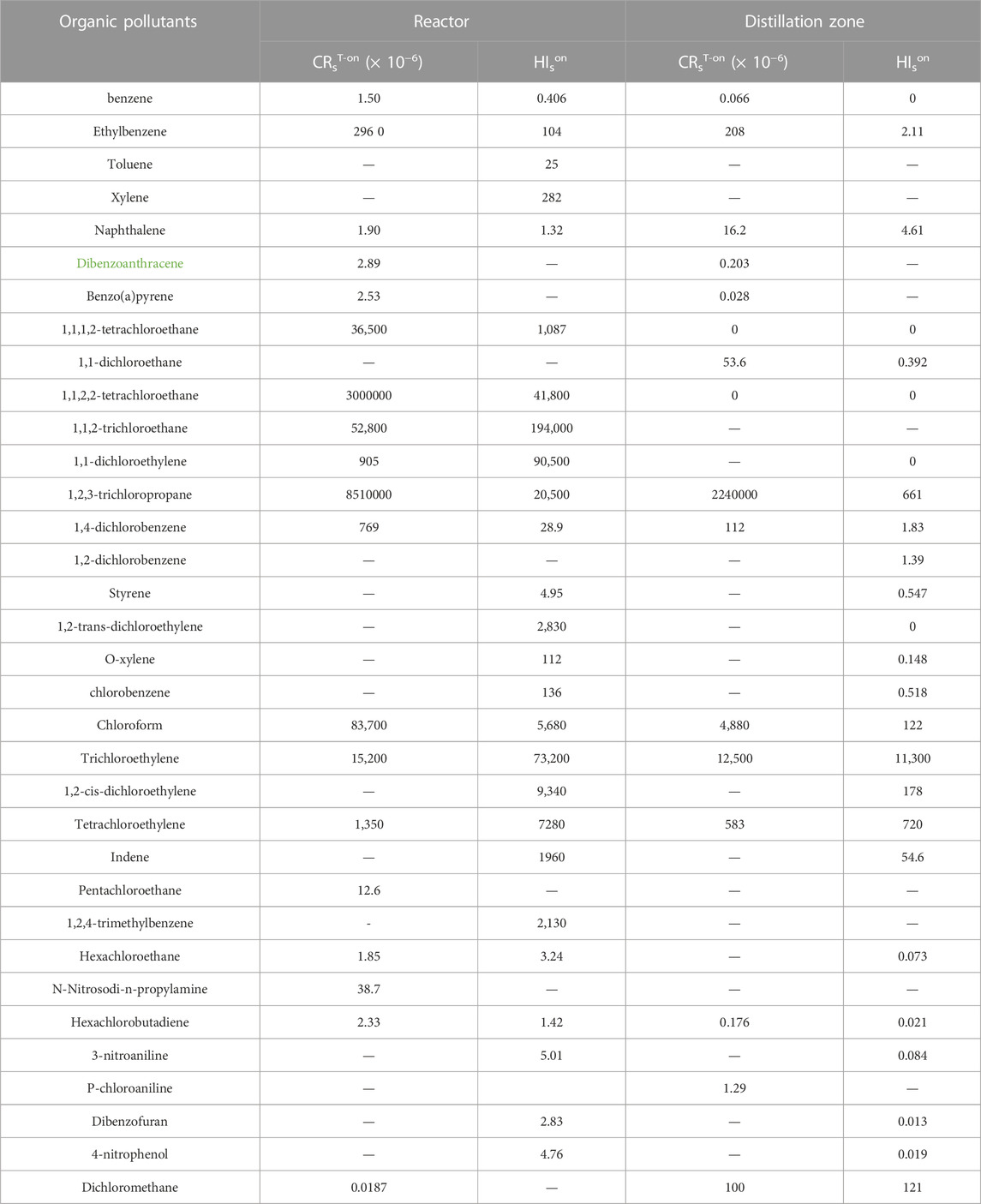- 1Technology Innovation Center for Land Engineering and Human Settlements, Shaanxi Land Engineering Construction Group Co., Ltd., and Xi’an Jiaotong University, Xi’an, China
- 2Shaanxi Provincial Land Engineering Construction Group Co., Ltd., Xi’an, China
- 3Institute of Land Engineering and Technology, Shaanxi Provincial Land Engineering Construction Group Ltd., Xi’an, China
- 4Key Laboratory of Degraded and Unused Land Consolidation Engineering, The Ministry of Natural Resources, Xi’an, China
- 5Shaanxi Provincial Land Consolidation Engineering Technology Research Center, Xi’an, China
- 6Shaanxi Key Laboratory of Land Consolidation, Xi’an, China
In general, chemical plants are accompanied by a variety of secondary production in the production process, which may have different degrees of impact on the environment. At the same time, in order to ensure the environmental safety of new urban construction land, it is necessary to conduct pollution investigation and further environmental risk assessment on potentially polluting abandoned chemical plants. This paper takes a chemical plant producing food grade fumaric acid in Northwest China as an example to investigate the pollution of organic matter in the soil in accordance with relevant standards, then analyzes the vertical pollution degree of key pollution areas. The calculation results of single factor pollution index and Nemerow pollution index show that there are 17 kinds of organic pollutants that exceed the screening value in land of Class I. Among them, benzene, 1,2,3-trichloropropane and 1,1,2,2-tetrachloroethane are most serious, and the highest exceeded the standard by 11,311 times. Moreover, the distillation zone and the reactor zone have reached the level of V pollution, and the maximum pollution depth can reach more than 6 m. The results of HERA software analysis showed that there were 18 and 10 kinds of organic pollutants with carcinogenic risk values exceeding 10−6 in the reactor and distillation area, respectively, and 25 and 11 kinds of organic pollutants with hazard quotients exceeding 1, respectively. According to relevant regulations, the contaminated areas with unacceptable regional risks must be properly repaired.
1 Introduction
The realization of industrialization and urbanization is an inevitable trend in the development of economic and social sciences, and it is also a necessary process to realize modernization. The realization of industrialization and urbanization is the inevitable trend of the development of economic and social sciences, and it is also the necessary process to realize modernization. However, this process has also changed the structure of the economy and ecosystem of urban areas, and triggered a series of ecological and environmental problems (Li and Lin, 2015; Huang et al., 2018). The essence of these problems is the deterioration of man-land relationship. Human beings and the environment are interdependent and mutually restrictive (Long and Qu, 2018; Megremi et al., 2019). Only by coordinating the human-land relationship can the sustainable development of the city be realized (Kuang et al., 2020; Zhang and Li, 2020). In 2013, China formally established the “people-oriented” new urbanization development strategy. The research shows that the development of urbanization in China has gradually changed from quantity expansion to quality improvement, which is mainly reflected in the optimization of ecological environment, urban function layout and industrial structure, as well as the improvement of social security system. The intensification and sustainability of land use has become a trend and has been widely recognized (Fang, 2019).
Urban soil is an important part of urban ecosystem and the natural foundation of urbanization. It is closely related to urban development and public health. A large number of pollutants produced by rapid industrialization and modern transportation eventually enter the urban soil directly or indirectly (Xiao et al., 2015; Ministry of Environmental Protection P.R.C., 2014). Soil is the ultimate receptor of most pollutants. Soil pollution is hidden, complex and lagging, so it is not easy to be noticed by people, and it is often concerned by the society after causing public safety incidents. In general, the main causes of pollution include: industrial point source and the agricultural non-point source pollution; unreasonable and excessive application of chemical fertilizers and pesticides; atmospheric harmful particles and water environmental pollution, etc. (Zhao, 2008, Padilla-Sánchez et al., 2015; Tao et al., 2002; Gillis et al., 2014; Collins et al., 2006). Among them, industrial point source pollution is the focus of this study. In recent years, the “poisonous land” incidents discovered in many cities are often caused by chemical, pesticide and other types of enterprises that are free to dispose of waste or “run and drip” during the production process. Compared with farmland soil, the organic pollutants in the soil of industrial sites tend to exhibit high concentration and small range, and the pollution is relatively concentrated (Luthy et al., 1994) (Richard et al., 1994). reported that there is a large amount of organic pollutants in the soil due to tar pollution in an industrial gas plant. PAHs (Polycyclic Aromatic Hydrocarbons) are one of the typical organic pollutants in industrial soils. A large number of literature have reported the content of PAHs in soils such as coal mines, coal yards and coking plants. The content of high-ring PAHs in the soil of a coal mining area in Russia’s tundra is three times the local background value (Yakovleva et al., 2016); and the content of PAHs in the soil of a coal yard in Indonesia and an abandoned coking plant in Nanjing, Jiangsu is 4.69–22.67 mg/kg and 114.8 mg/kg, respectively (Mizwar et al., 2016; Ye et al., 2017).
With the rapid development of social economy, the continuous advancement of urbanization and the adjustment of industrial structure, many enterprises, especially those that produce high pollution in the production process, are relocated or shut down from the city, and the industrial sites left or abandoned are Urban development provides new land resources (Yuan et al., 2005). However, public safety incidents caused by contaminated sites have attracted widespread attention. In July 2006, Suzhou relocated 20 mu of toxic land left by chemical enterprises, resulting in six construction workers unconscious during excavation. In 2007, during the construction of Heshan block in Wuhan, workers were poisoned and rushed to the hospital. It was found that the place was originally a pesticide factory in Wuhan. In April 2014, benzene pollution in tap water in Lanzhou led to drinking water panic among citizens. It was later found that two major pollution accidents occurred in 1987 and 2002 in petrochemical enterprises in the region. Coupled with the existence of multiple pollution sources around the region, long-term pollution accumulation eventually caused soil and groundwater pollution. Under the accumulation of human industrial activities, the accumulation of pollutants in the contaminated site causes the content of pollutants to exceed the standard, the physical and chemical and biological characteristics of the soil to mutate, which stimulates and physiologically poisons the plants and animals on which they depend, and has a certain selection and induction effect on the number of organisms and species (Yu, 2014). While changing the soil environmental ecosystem, the pollutants accumulated in the soil will eventually harm human health through the enrichment of the food chain. On the other hand, under natural sudden factors such as rainfall and debris flow, the transfer of pollutants will be further accelerated, which will have a serious impact on groundwater and surrounding soil environment and threaten the health of residents (Li Q. H. et al., 2022; Li X. S. et al., 2022). In general, site pollution will inevitably cause soil structure damage, and barren, water source scrapping and ecological environment damage, etc., and the resulting direct or indirect economic losses and ecological disasters will be unbearable to human beings.
Therefore, these sites need to be investigated for their pollution level and pollution range before re-use, and conduct health risk assessment to determine the risk level of the future use of the site and to develop corresponding control and management measures accordingly (Nam et al., 2013; Zheng et al., 2017). At present, European and American countries are in the leading position in the research of site health risk assessment technology. Based on different risk types (human health ecological risk) and risk levels, they have formulated soil screening values for different land use methods such as residential, commercial and industrial land, and combined them with different management strategies and remediation measures. However, the research on health risk assessment of contaminated land in China is still in its infancy. Zhu et al. (Zhu et al., 2013) evaluated the ecological and health risk effects of heavy metals in pesticide enterprise sites and surrounding topsoil by using the Nemerow composite index method, Hankanson potential risk index method and the human exposure risk assessment method in the United States. Most domestic scholars only consider the comprehensive carcinogenic and non-carcinogenic risks of all exposure pathways of pollutants when assessing site health risks (Guo et al., 2010; Li, 2010; Luo et al., 2012). Fang et al. (Fang et al., 2013) used the RBCA model to conduct soil stratification health assessment of contaminated sites. According to the results of stratified assessment, the scope of remediation of contaminated soils at various levels was demarcated, which could reduce the amount of soil excavation in site remediation. Dong et al. (Dong et al., 2015) carried out a multi-level health risk assessment for an organic contaminated site in the south and reduced the cost of repair. It was found that the target value of the remediation of pollutants in the soil increased with the depth of the soil layer.
The research object of this paper is an abandoned food-grade fumarate factory. In the previous exploration, it was found that the air in this site was obviously aromatic, so we concluded that the soil in the site should be polluted by organic matter. Therefore, we further carried out on-site investigation, sampling, detection, analysis and evaluation, and studied the pollution status and distribution characteristics of organic pollutants in the soil of this site. At the same time, the environmental risk status of this site was further evaluated using China’s first HERA (Health and Environmental Risk Assessment Software for Contaminated Sites) software developed by the Nanjing Institute of Soil Research, Chinese Academy of Sciences in 2012. The research results of this paper will provide a basis for the follow-up development planning, engineering treatment measures and protection level of construction personnel, so as to further improve the soil and groundwater environment in the site, ensure the safety and health of local people, and provide guarantee for the healthy development of regional economy and society.
2 Materials and methods
2.1 Site overview
The site studied in this paper is located in the eastern part of Weinan City, Shaanxi Province, China. The geomorphic unit belongs to the first-order terrace of the Weihe River. The elevation is between 342.79 m and 351.17 m. The terrain is relatively flat, covering an area of about 8,690 m2. The lithology is light yellow and brownish yellow sandy clay, with a layer of brown viscous layer on the upper part, with a thickness of about 1–1.5 m. After investigation, we learned that the site is a contaminated site left by a fine chemical enterprise. It has always been an industrial land. It was originally a chemical plant that produces pesticides. After restructuring, it mainly produces food-grade fumaric acid, cold water-soluble food-grade fumaric acid, ultra-fine-grained fumaric acid, cationic etherification agent and other products. The annual production capacity is 10 million tons, 1,500 tons, 1,000 tons, and 500 tons, respectively. Phthalic acid is usually used as raw material to produce phthalic anhydride by fixed bed catalytic oxidation technology. Phthalic acid is heated under the action of catalyst and mixed with hot air to produce phthalic anhydride. The by-product is maleic anhydride, which is converted into maleic acid after cooling, switching, condensing and washing (Zhang and Min, 2002; Li et al., 2005). Finally, fumaric acid is further isomerized to fumaric acid by using the solubility of fumaric acid in water is less than the solubility of maleic acid in water.
The staff dormitory is located in the southeast of the plant, the workspace is located on the south side of the plant, and the distillation zone, factory building, benzene reaction zone, and sewage pool are distributed in the north and central parts of the plant. The floor plan and the layout imagery of the factory are shown in Figure 1 and Figure 2, respectively.
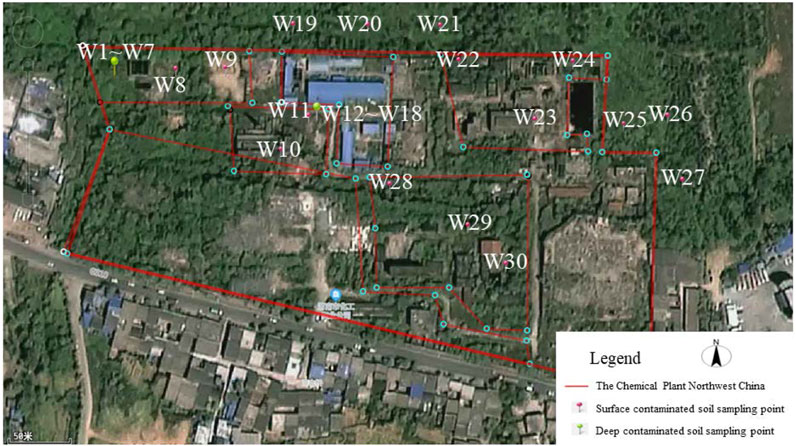
FIGURE 2. The layout imagery of the chemical factory and Sampling point diagram (W1: Distillation Zone A 0∼1 m; W2: Distillation Zone 1.5–2.0 m; W3: Distillation Zone 2.0–2.5 m; W4: Distillation Zone 2.5–3.0 m; W5: Distillation Zone 4.0–5.0 m; W6: Distillation Zone 5.0–6.0 m; W7: Distillation Zone >6.0 m; W8: Distillation Zone B 0∼1 m; W9: Distillation Zone C 0∼1 m; W10: Reactor Zone A 0–0.5 m; W11: Reactor Zone B 0–0.5 m; W12: Reactor Zone C 0–0.5 m; W13: Reactor Zone 0.5–1.0 m; W14:Reactor Zone 1.0–1.5 m; W15: Reactor Zone 1.5–2.0 m; W16: Reactor Zone 2.0–2.5 m; W17: Reactor Zone 2.5–3.0 m; W18: Reactor Zone 3.0–4.0 m; W19: North Side of Chemical Plant A; W20: North Side of Chemical Plant B; W21: North Side of Chemical Plant C; W22: Benzene Reaction Zone A; W23: Benzene Reaction Zone B; W24: Benzene Reaction Zone C; W25: East side of chemical plant A; W26: East side of chemical plant B; W27: East side of chemical plant C; W28: Benzene Reaction Zone D; W29: Benzene Reaction Zone E; W30: Benzene Reaction Zone F).
2.2 Sampling point layout and sample collection and preparation
According to technical guidelines for environmental site investigaiton (Ministry of Ecology and Environment of the people’s republic of China, 2014a), the partitioning layout method and the system layout method were combined for on-site sampling. On the basis of site pollution identification, and taking into account the distribution of the entire plant area and the external environment of the plant, the sampling area is divided into 8 (as shown in Figure 2).
Due to the unresolved demolition in the chemical plant, some areas such as the distillation zone, benzene reaction zone, plant zone, east side sewage pool and dormitory area of the chemical plant are temporarily unable to be sampled and investigated under the effect of hardened ground or undismantled workshops. The organic pollution investigation is carried out in the office area, reactor, distillation zone and other areas that meet the sampling conditions, and 3 sampling points are set in each area. Each sampling point is centered on this point, and five equal soil samples are uniformly collected at the circumference and center of the circle with a diameter of 10 m. After sampling, the samples are immediately loaded into a sealed container to reduce the exposure time. W19-W21 and W25-W27 were selected as control monitoring points in the external area of the site.
At the same time, deep soil sampling points were set up in several suspected contaminated areas, such as distillation area, sewage tank in distillation area, reactor and benzene reaction area, so as to further judge the longitudinal pollution range of pollutants in soil. Surface soil samples were collected by drilling method. The basic requirement of soil sampling is to minimize soil disturbance and ensure that soil samples are not secondary polluted during sampling. The collection of deep soil is mainly based on the manual drilling of the tubular sampler, supplemented by the hydraulic soil sampling drill (Phino HPD60). The sampling sequence is from bottom to top. First, the bottom samples of the profile are collected, then the middle samples are collected, and finally the upper samples are collected. The sampling points in different regions are shown in Table 1.
Remove the impurities on the surface soil before sampling, and mix the soil sample into a sealed bag, then transfer it to a brown glass bottle so that the soil sample fills the entire glass bottle. At last, Seal it with a sealing film and stick the label, then store and transport in an incubator below 4°C, which refers to the requirements of “The Technical Specifications for Soil Environmental Monitoring” (Ministry of Ecology and Environment of the people’s republic of China, 2014b) for details.
The depth of sampling should remove the thickness of surface non-soil hardened layer. The sampling interval of 0–3.0 m is set to 0.5 m, the sampling interval of 3.0–6.0 m is set to 1.0 m, the sampling interval below 6.0 m to the groundwater level is planned to be 2.0 m. The specific interval can be adjusted according to the actual situation. The mutual pollution and disturbance between different soil layers should be avoided during sampling.
2.3 Sample analysis methods
The collected soil samples were subjected to rapid on-site analysis of organic matter using a portable gas chromatography mass spectrometer Mars-400 Plus (The mass range is 15-550 amu, and the detection limit is less than ppb), which in order to quickly predict the pollution level of the chemical plant. According to the results of rapid detection, the soil samples with higher rapid detection values were taken and further sent to Focused Photonics Inc. (Hangzhou) Co., Ltd., which has the qualification of organic matter detection, to determine the degree and depth of pollution in the organic area. The detection methods of organic matter in soil samples were tested according to the standard methods given in Soil environmental quality-Risk control standard for soil contamination of development land (Ministry of Ecology and Environment of the people’s republic of China, 2018). Microsoft Excel 2010 and Origin Pro 2021 were used for data recording and preliminary analysis, and the Health and Environmental Risk Assessment Software for Contaminated Sites (HERA) was used to assess the ecological risk of the site.
2.4 Method of environmental quality evaluation of soil
2.4.1 Evaluation method
In this paper, the Nemerow comprehensive pollution index method (Nemerow, 1974) is used to evaluate the degree of soil organic matter pollution. This method not only considers the average value of the single factor pollution index, but also considers the prominent factors of the heavier pollution factor, which can comprehensively reflect the overall quality of soil organic matter.
Single gene index:
N. L. Nemerow:
Where Ci is the concentration of organic matter i; Si is the soil evaluation standard, taking the screening values in land of Class I of Soil environment quality risk control standard for soil contamination of development land (Ministry of Ecology and Environment of the people’s republic of China, 2018)as the evaluation standard, and Pi and PN are the single factor pollution index and Nemerow comprehensive pollution index, respectively.
2.4.2 Evaluation standard
The evaluation standard adopts “Soil environment quality risk control standard for soil contamination of development land”, and the Nemerow comprehensive pollution index is shown in Table 2.
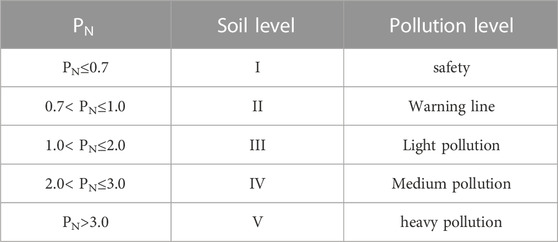
TABLE 2. Classification of environmental quality assessment by Nemerow comprehensive pollution index.
2.5 Health risk assessment
Health risk assessment is a process to quantify the potential harm of environmental problems to human health. There are eight ways in which organic pollutants in the soil may cause harm to human health. They are oral intake of soil, skin contact with soil, inhalation of indoor soil particles, inhalation of outdoor soil particles, inhaling gaseous pollutants from the surface soil in the outdoor air, inhaling gaseous pollutants from the subsoil in the outdoor air, inhaling gaseous pollutants from the subsoil in the indoor air, and leaching from soil to groundwater. According to the planning of the area, it is designated as sensitive land. For carcinogenic effects, consider the lifetime exposure risk of the population, generally assess the lifetime cancer risk of the pollutant according to the exposure of childhood and adult; for non-carcinogenic effects, children are lighter in weight and have higher exposures, and the non-carcinogenic hazard effects of contaminants are generally assessed based on childhood exposure.
The HERA software used in this study is China’s first contaminated site health and water environment risk assessment software developed by the Nanjing Institute of Soil Research, Chinese Academy of Sciences. It is based on Standard Guide for Risk-Based Corrective Action (ASTM International, 2015) in the United States, and Updated Technical Background to the CLEA Model (UK EA, 2009) in the UK, and Technical Guidelines for Risk Assessment of Contaminated Sites (Ministry of Ecology and Environment of the people’s republic of China, 2014c) in China. It is suitable for multi-level soil and groundwater risk assessment of contaminated sites, and can be used for quantitative risk assessment based on the protection of human health and water environment.
3 Results
3.1 Analysis of main polluted organic matter in soil
There are 30 testing points of soil in the chemical plant area, and most of the sites have detected organic pollutants, especially distillation zones and reactors. A total of 87 organic substances were detected in each soil testing point, and 17 organic pollutants exceeded the screening value in land of Class I, of which more than 65% existed in the range of 0–1.0 m in the reactor zone and 1.0–1.5 m in the distillation zone, as shown in Table 3. The highest rate of benzene and 1, 2, 3-trichloropropane is 40%, which is basically distributed in the reactor from 0 to 1.5 m, and the distribution in the distillation zone is as deep as 6 m or more. Benzene and 1, 2, 3-trichloropropane have the highest over-limit ratio, both are 40%, which is basically distributed in the reactor zone from 0 to 1.5 m, and the distribution in the distillation zone is as deep as 6 m or more. 1,2,3-trichloropropane has the highest single factor pollution index, which is 11,311 times higher than the screening value in land of Class I. Followed by 1,1,2,2-tetrachloroethane, its exceed multiple is 4,751 times. Since the benzene reaction zone in the chemical plant is basically hardened ground or undismantled workshops, the actual soil sample is dust collecting on the surface of the road. Only the presence of nitrobenzene is found in the test, which is 0.44 times higher than the first type of screening value.
3.2 Site soil pollution assessment
Through the Nemerow Index method, we can further understand the soil pollution status of the chemical plant. Firstly, after analyzing the soil pollution of different surface areas, the soil in the distillation zone and the reactor is already heavily polluted. The dust on the hardened road surface of the benzene reaction zone is light pollution, while the soil on the north and east sides of the chemical plant is not polluted, which belongs to the security level, as shown in Table 4.
For the heavily polluted area, such as reactor zone, distillation zone, further analysis of longitudinal pollution conditions is shown in Table 5. For the reaction zone, 0–2.0 m soil belongs to class V heavy pollution, and there is no pollution after 2.0 m. The degree of vertical soil pollution increased first and then decreased with the increase of soil depth. Among them, the pollution of 0.5–1.0 m was the most serious, and the comprehensive pollution index of Nemerow was as high as 3360.7. It is presumed that there are about 7980 m3 of contaminated soil in this area. The soil with a depth of more than 6 m in the distillation zone is lightly and moderately polluted. The change of the degree of vertical soil pollution is consistent with the reactor, and it also increases and then decreases with the increase of soil depth, at a depth of 1.5–2.0 m. The pollution level is the largest. The Nemerow comprehensive pollution index is 7999.8, which is 2.38 times of the highest reactor index. It is estimated that the contaminated soil is about 30,000 m3.
4 Discussion
4.1 Hazards of main organic pollutants in soil
According to the assessment results, the contamination of chlorinated hydrocarbons, benzene and its homologues and derivatives were relatively severe, especially chlorinated hydrocarbons. As an important organic solvent and product intermediate, chlorinated organic compounds are widely used in many industries. This fumaric acid plant is no exception, but these substances are often carcinogenic, teratogenic and mutagenic. Since the chemical plant is a non-sensitive land, the adult has a long exposure period and a high frequency of exposure. And the carcinogenic risk (CR) and hazard quotient (HQ) of the pollutant are generally evaluated according to the adult exposure. There are 8 kinds of exposure pathway. Firstly, in the CR of each pathway (Figure 3) from HERA analysis results, whether in the reactor or in the distillation zone, the CR leaching from soil to groundwater (CRssl−TOX) is the highest, and the relation of all the pathway is: the CR leaching from soil to groundwater (CRssl-TOX)> the CR of inhaling gaseous pollutants from the subsoil in the indoor air (CRsiv)> the CR of inhaling gaseous pollutants from the subsoil in the outdoor air (CRssub-ov)> the CR of oral intake of soil (CRsing) > the CR of skin-contacted soil (CRsder)> the CR of outdoor steam inhaled into the surface soil (CRssur-ov)> the CR of inhaling of indoor soil particles (CRsip)> the CR of inhaling outdoor soil particles (CRsop). The total carcinogenic risk in all pathways (CRsT-on) up to 11.7. Similarly, the HQ leaching from soil to groundwater (HQssl-TOX) is the highest in the distillation zone. But HQsiv is the highest in the reactor zone. Furthermore, the HQ of each pathway of the reaction zone is larger than the distillation zone, up to 15–130 times. Therefore, the groundwater near the chemical area should be the key monitoring area, and the lower soil should be strictly treated and monitored before secondary development.
Refer to the technical guidelines for the assessment of contaminated sites. If the CR value of a single pollutant exceeds 10−6 or the sampling point of the HQ exceeds 1, the area of the site represented should be classified as an unacceptable contaminated area. As shown in Table 6 from HERA analysis results, 18 kinds of pollutants in the reactor area have a CR value of more than 10−6, mainly chlorinated hydrocarbons, benzene series, etc. Among them, 1,2,3-trichloropropane has the highest CR, which has reached 8.51, and followed by 1,1,2,2-tetrachloroethane, which is 3. In the distillation zone, there are 10 kinds of pollutants with a CR of more than 10−6, and the CR of 1, 2, 3-trichloropropane is also the highest, which is 2.24. For the HQ, there are 21 kinds of pollutants in the reaction zone and 10 kinds of pollutants in the distillation zone exceed the safety value, respectively. Overall, the CR and HQ of the reaction zone are higher than the distillation zone, and both zones are unacceptable contaminated area and must be properly repaired.
4.2 Brownfield development based on man-land relationship
Urban development is a dynamic process. In the process of rapid urban expansion, land use patterns are also changing (Wang et al., 2018). Although the urbanization rate has increased, the urban ecological environment has deteriorated and the urban function has been missing. In this context, the development of urban brownfields is inefficient and unsafe. In this study, the study area was originally an industrial agglomeration area. Although the chemical plant has been abandoned for secondary development, the nearby area not only bears some urban functions, such as logistics and warehousing, but also lives some local villagers. From the above analysis, it can be seen that some areas of the chemical area have become risk unacceptable pollution areas, and their CR values and HQ values are very high, and after redevelopment, the organic pollutants in the lower soil steam will pose risks to indoor and outdoor people. However, through on-site investigation, it can be found that there are still places where people are active. It looks like a small community, involving a variety of activities, such as living and dining, not affected by the pungent smell of the area, posing a great threat to the ecological environment and human health.
In recent years, people have become more sensitive to the way land is used. The improvement of ecological environment quality is the core of urban development. In the process of brownfield development, we should pay attention to the connection with the surrounding land. The development of brownfields is of great significance to the improvement of urban functions and the improvement of land economic benefits. More importantly, the development of brownfields is of great significance for ensuring land security and regional ecological environment construction. On the one hand, it is necessary to fully protect and rectify land pollution and avoid the destruction of the ecological environment to the surrounding areas. On the other hand, the development of brownfields needs to start from people’s needs, especially the needs of surrounding residents. From the perspective of city managers, public participation of stakeholders will help to develop more reasonable site land use planning programs, rather than spontaneous programs.
In general, the environmental risk, remediation cost, redevelopment environment, social and economic benefits of multiple contaminated plots in the region should be considered in the sustainable brownfield regeneration of regional scale sites, so as to provide a basis for the decision-making of regional land safety utilization planning. However, at present, the development structure of China’s environmental restoration industry is not perfect. In recent years, due to the increasingly urgent needs of China’s soil remediation market, the continuous investment of national and local laws and regulations and national special funds, the rapid expansion of China’s site remediation market has led to a large number of state-owned and social capital investment. However, from the perspective of restoration engineering technology, most of the restoration institutions are transformed from traditional construction earthwork or solid waste disposal projects. Professional environmental restoration equipment and institutions are still scarce, environmental restoration supervision is insufficient, and there is a lack of professional technical guidance, evaluation institutions and personnel. The proportion of environmental investigation and evaluation is very small, which leads to the lack of refined-whole-process site investigation, which indirectly causes a lot of waste of repair resources (Zhang et al., 2017). Therefore, the sustainable reuse of brownfields and the healthy development of environmental industry in China still face great room for improvement.
5 Conclusion
Based on the detection of more than 80 organic pollutants in the soil in the chemical plant area that has been shut down, this study found that 17 organic pollutants exceeded the standard and were basically distributed in the reaction zone and distillation zone, and the main pollutant were chlorinated hydrocarbons and benzenes. The pollution levels of both areas have all reached Class V and the pollution depth is up to 6 m. Among them, 1,2,3-trichloropropane has the highest single factor pollution index, which is 11,311 times higher than the screening values in land of Class I. In the reaction zone and distillation zone, its CR and HQ are also the highest, which has exceeded hundreds or even millions of times than safety value. At the same time, more than a dozen other organic pollutants have the carcinogenic risk and hazard quotient that exceed safety limits, indicating that the sites should be classified as unacceptable contaminated areas. Therefore, before the land development in this area, it is necessary to take appropriate measures to first repair the soil, such as thermal desorption, gas phase extraction, chemical leaching, etc. to achieve sustainable development. However, Due to the limitation of site conditions, the setting of soil sampling points is less, which may affect the prediction accuracy of pollutant distribution results. According to the project advancement, sampling points should be increased in the later stage to improve the accuracy of soil restoration prediction.
Data availability statement
The raw data supporting the conclusion of this article will be made available by the authors, without undue reservation.
Author contributions
LW: Formal Analysis, Methodology, Project administration, Software, Writing–original draft, Writing–review and editing. XX: Formal Analysis, Investigation, Methodology, Software, Writing–original draft. SL: Conceptualization, Data curation, Resources, Validation, Visualization, Writing–review and editing. JW: Formal Analysis, Software, Supervision, Writing–review and editing. BP: Funding acquisition, Project administration, Writing–review and editing. YS: Funding acquisition, Project administration, Resources, Writing–review and editing.
Funding
This research is supported by Innovation Capability Support Program of Shaanxi (Program No. 2023-CX-RKX-102), the Open Fund of Shaanxi Key Laboratory of Land Consolidation (30010235 2502), Technology Innovation Center for Land Engineering and Human Settlements, Shaanxi Land Engineering Construction Group Co., Ltd and Xi’an Jiaotong University (Program No. 2021WHZ0090) and Xi’an Science and Technology Plan Project (Program No. 22NYYF028), and the project of Shaanxi Provincial Land Engineering Construction Group (Program No. DJTD-2022-4, Program No. DJNY2022-38, Program No. DJTD-2023-2, Program No. DJNY-YB-2023-35), and we thank research staffs for their contributions to this work.
Acknowledgments
We thank research staffs for their contributions to this work.
Conflict of interest
Authors LW, XX, SL, JW, and YS were employed by Shaanxi Provincial Land Engineering Construction Group Co., Ltd.
The remaining author declares that the research was conducted in the absence of any commercial or financial relationships that could be construed as a potential conflict of interest.
The authors declare that this study received funding from Shaanxi Provincial Land Engineering Construction Group Co. Ltd. The company had the following involvement in the study: design, data collection and analysis.
Publisher’s note
All claims expressed in this article are solely those of the authors and do not necessarily represent those of their affiliated organizations, or those of the publisher, the editors and the reviewers. Any product that may be evaluated in this article, or claim that may be made by its manufacturer, is not guaranteed or endorsed by the publisher.
References
ASTM International (2015). Standard guide for risk-based corrective action. American Society of Testing Materials.
Collins, C., Fryer, M., and Grosso, A. (2006). Plant uptake of non-ionic organic chemicals. Environ Sci. Technol. 40, 45–52. doi:10.1021/es0508166
Dong, M. G., Zhang, J. R., Luo, F., Han, L., Yan, J. C., and Chen, M. F. (2015). Health risk assessment of soil and groundwater for A typical organic chemical contaminated site in sourthern China. Soils 47, 100–106. doi:10.13758/j.cnki.tr.2015.01.016
Fang, C. (2019). Basic rules and key paths for high-quality development of the new urbanization in China. Geogr. Res. 38 (01), 13–22. doi:10.11821/dlyj020180445
Fang, J. D., Du, X. M., Li, Z., Xu, Z., Shi, Y., Li, H. Y., et al. (2013). Health risk assessment for multi-layer soils in a compound chemical contaminated site. J. Environ. Eng. Technol. 3, 451–457. doi:10.3969/j.issn.1674-991X.2013.05.070
Gillis, J. D., and PriceStratton, G. W. G. W. (2014). Detection and degradation of organic contaminants in an agricultural soil amended with alkaline-treated biosolids. Can. J. Soil Sci. 94, 595–604. doi:10.4141/cjss2013-123
Guo, G. L., Wang, S. J., Shi, L. Y., Li, H. Y., Han, C. M., Gu, Q. B., et al. (2010). Health risk analysis of VOC/SVOC contaminated soil in an abandoned chemical plant. Environ. Sci. 31, 397–402. doi:10.13227/j.hjkx.2010.02.018
Huang, G., Zhang, M., Liu, C., Li, L., and Chen, Z. (2018). Heavy metal(loid)s and organic contaminants in groundwater in the pearl river delta that has undergone three decades of urbanization and industrialization: Distributions, sources, and driving forces. Sci. Total Environ. 635, 913–925. doi:10.1016/j.scitotenv.2018.04.210
Kuang, B., Lu, X. H., Han, J., Fan, X. Y., and Zuo, J. (2020). How urbanization influence urban land consumption intensity: Evidence from China. Habitat Int., 102013. doi:10.1016/j.habitatint.2019.102103
Li, K., and Lin, B. (2015). Impacts of urbanization and industrialization on energy consumption/CO2 emissions: Does the level of development matter? Renew. Sust. Energ. Rev. 52, 1107–1122. doi:10.1016/j.rser.2015.07.185
Li, Q. H., Song, D. Q., Yuan, C. M., and Nie, W. (2022a). An image recognition method for the deformation area of open-pit rock slopes under variable rainfall. Measurement 188, 110544. doi:10.1016/j.measurement.2021.110544
Li, Q. Q. (2010). Procedures and methodology for studying soil remediation objectives based on the human risk assessment -A case study of reuse of PAH-contaminated soil in shanghai. J. Ecol. Rural. Environ. 26, 610–615.
Li, X. K., Zhang, K., Gao, Z., Liu, N., and Huang, H. (2005). Process in synthesis and application of fumaric acid. Mod. Chem. Ind. 7. doi:10.16606/j.cnki.issn0253-4320.2005.s1.021
Li, X. S., Li, Q. H., Hu, Y. J., Chen, Q. S., Peng, J., Xie, Y. L., et al. (2022b). Study on three- dimensional dynamic stability of open-pit high slope under blasting vibration. Res. Article 2021, 6426550. doi:10.2113/2022/6426550
Long, H., and Qu, Y. (2018). Land use transitions and land management: A mutual feedback perspective. Land Use Policy 74, 111–120. doi:10.1016/j.landusepol.2017.03.021
Luo, F., Song, J., Pan, Y. Y., Wei, J., Huang, Y. J., Wu, C. F., et al. (2012). Human health risk assessment of contaminated soil: A case study of A former ddt manufacturing site. Acta Pedol. Sin. 49, 26–35.
Luthy, R. G., Peters, C. A., Roy, S. B., Ramaswami, A., Nakles, D. V., Nott, B. R., et al. (1994). Remediating tar-contaminated soils at manufactured gas plant sites. Environ. Sci. Technol. 28, 266A–276A. doi:10.1021/es00055a002
Megremi, I., Vasilatos, C., Vassilakis, E., and Economou-Eliopoulos, M. (2019). Spatial diversity of cr distribution in soil and groundwater sites in relation with land use management in a mediterranean region: The case of c. evia and assopos-thiva basins, Greece. Sci. Total Environ. 651, 656–667. doi:10.1016/j.scitotenv.2018.09.186
Ministry of Ecology and Environment of the people’s republic of China (2018). Soil environmental quality-Risk control standard for soil contamination of development land. China Environmental Science Press.
Ministry of Ecology and Environment of the people’s republic of China (2014a). Technical guidelines for environmental monitoring of sites. China Environmental Science Press.
Ministry of Ecology and Environment of the people’s republic of China (2014c). Technical guidelines for environmental monitoring of sites. China Environmental Science Press.
Ministry of Ecology and Environment of the people’s republic of China (2014b). The technical Specifications for soil environmental monitoring. China Environmental Science Press.
Ministry of Environmental Protection P.R.C. (2014). Ministry of Land and Resources P.R.C.link Report on the national general survey of soil contamination[EB/OL]. Available at: https://www.mee.gov.cn/gkml/sthjbgw/qt/201404/t20140417_270670_wh.htm.
MizwarPriatmadiAbdiTrihadiningrum, A. B. J. C. Y. (2016). Assessment of polycyclic aromatic hydrocarbons (PAHs) contamination in surface soil of coal stockpile sites in South Kalimantan, Indonesia. Environ. Monit. Assess. 188, 152. doi:10.1007/s10661-016-5166-x
Nam, K., Jho, E. H., and Lee, J. Y. (2013). Risk assessment of environmental pollutants in korea for soil and groundwater remediation. Hum. Ecol. Risk Assess. 19, 723. doi:10.1080/10807039.2013.773237
Padilla-Sánchez, J. A., Romero-González, R., Plaza-Bola OsGarrido FrenichVidal, P. A. M., and José, L. (2015). Residues and organic contaminants in agricultural soils in intensive agricultural areas of Spain: A three years survey. Clean. - Soil, Air, Water 43, 746–753. doi:10.1002/clen.201300583
Tao, S., Cui, Y. H., Cao, J., Xu, F. L., Dawson, R., and Li, B. G. (2002). DETERMINATION OF PAHs IN WASTEWATER IRRIGATED AGRICULTURAL SOIL USING ACCELERATED SOLVENT EXTRACTION. J. Environ. Sci. Heal. B 37, 141–150. doi:10.1081/pfc-120002986
UK EA (2009). Updated technical background to the CLEA model. Bristol: The Environment Agency in England and Wales.
Wang, J., Lin, Y. F., Glendinning, A., and Xu, Y. Q. (2018). Land-use changes and land policies evolution in China’s urbanization processes. Land Use Policy 75, 375–387. doi:10.1016/j.landusepol.2018.04.011
Xiao, Q., Zong, Y. T., and Lu, S. G. (2015). Assessment of heavy metal pollution and human health risk in urban soils of steel industrial city (Anshan), Liaoning, Northeast China. Ecotox. Environ. Safe. 120, 377–385. doi:10.1016/j.ecoenv.2015.06.019
Yakovleva, E. V., Gabov, D. N., Beznosikov, V. A., and Kondratenok, B. M. (2016). Accumulation of polycyclic aromatic hydrocarbons in soils and plants of the tundra zone under the impact of coal-mining industry. Eurasian Soil Sci. 49, 1319–1328. doi:10.1134/s1064229316090143
Ye, M., Sun, M. M., Xie, S. N., Liu, K., Feng, Y. F., Zhao, Y., et al. (2017). Feasibility of tea saponin-enhanced soil washing in a soybean oil-water solvent system to extract PAHs/Cd/Ni efficiently from a coking plant site. Pedosphere 27, 452–464. doi:10.1016/s1002-0160(17)60341-2
Yu, Q. F. (2014). Evaluation on soil pollution of coal mine industrial site and its reuse—a case study of pingshuo coal mine. China University of Geosciences (Beijing.
Yuan, W., Yang, K. X., and Xu, Q. X. (2005). Effect of urbanization on growth of Shanghai river function and stream structure. Res. Environ. Yangtze Basin 14, 133–138.
Zhang, H., and Min, C. C. (2002). Study on the production process of fumaric acid. Sci. Technol. Chem. Indus. 10, 53–55. doi:10.16664/j.cnki.issn1008-0511.2002.05.021
Zhang, H. Z., Dong, J. Q., Gao, S. D., and Wang, J. N. (2017). Healthy development suggestions for soil remediation industry in China. Environ. Prot. 45 (11), 4. doi:10.14026/j.cnki.0253-9705.2017.11.009
Zhang, X. L., and Li, H. (2020). The evolving process of the land urbanization bubble: Evidence from Hangzhou. China: Cities.102724
Zheng, H. T., Kou, K. P., and Ge, Y. (2017). Environmental risk assessment of the municipal solid waste in city-state: A case study of Macao. Hum. Ecol. Risk Assess. 23, 1798–1818. doi:10.1080/10807039.2017.1346463
Keywords: polluted sites, organic pollution, pollution level, carcinogenic risk, hazard quotient
Citation: Wang L, Xie X, Liu S, Wang J, Peng B and Sun Y (2023) Soil organic pollution and ecological risk assessment in brownfield soil from Northwest China: an integrated analysis of man-land interrelations. Front. Environ. Sci. 11:1271299. doi: 10.3389/fenvs.2023.1271299
Received: 02 August 2023; Accepted: 30 August 2023;
Published: 14 September 2023.
Edited by:
Mezbaul Bahar, The University of Newcastle, AustraliaReviewed by:
Manuel Miguel Jordán, Miguel Hernández University of Elche, SpainQihang Li, Chongqing University, China
Copyright © 2023 Wang, Xie, Liu, Wang, Peng and Sun. This is an open-access article distributed under the terms of the Creative Commons Attribution License (CC BY). The use, distribution or reproduction in other forums is permitted, provided the original author(s) and the copyright owner(s) are credited and that the original publication in this journal is cited, in accordance with accepted academic practice. No use, distribution or reproduction is permitted which does not comply with these terms.
*Correspondence: Biao Peng, cGVuZ2JpYW8xOTg4QGhvdG1haWwuY29t
 Luyao Wang
Luyao Wang Xiao Xie1,2,3,4,5
Xiao Xie1,2,3,4,5 Siqi Liu
Siqi Liu Jing Wang
Jing Wang